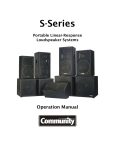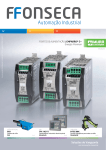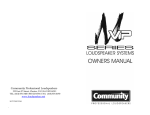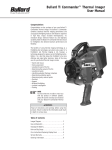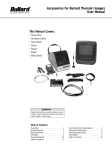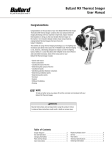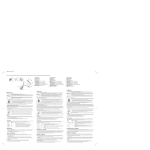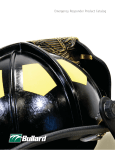Download Community MVP Series II Owner`s manual
Transcript
OWNER’S MANUAL Community Professional Loudspeakers 333 East 5th Street Chester, PA USA 19013-4511 Community MVP™ Series II Loudspeaker Systems Owner’s Manual Table of Contents EC STATEMENT OF CONFORMITY........................................................................................................... 2 INTRODUCTION........................................................................................................................................... 3 MVP™ Series II Loudspeaker Systems from Community ...................................................................... 3 Features ....................................................................................................................................................... 3 Unpacking and Inspection....................................................................................................................... 4 Important Safety Information................................................................................................................... 4 Cautions and Warnings ............................................................................................................................ 4 Loud Sound - Please Be Careful! ............................................................................................................. 5 CONNECTING YOUR LOUDSPEAKERS TO YOUR AMPLIFIER ............................................................. 6 Maintaining Proper Polarity ...................................................................................................................... 6 WHAT AMPLIFIER SHOULD YOU USE? ................................................................................................... 7 Determining Power Ratings ...................................................................................................................... 7 Using the Right Amplifier ........................................................................................................................... 7 About Impedance..................................................................................................................................... 8 USING THE MVP18S SUBWOOFER SYSTEM........................................................................................... 9 STACKING OR INSTALLING LOUDSPEAKER ENCLOSURES ............................................................. 10 ABOUT DYNA-TECH™ DRIVER PROTECTION ...................................................................................... 11 How Community’s Dyna-Tech™ Circuitry Works ................................................................................ 11 GRILLE REMOVAL AND INSTALLATION................................................................................................13 Grille Removal .......................................................................................................................................... 13 Grille Installation ....................................................................................................................................... 14 WARRANTY AND SERVICE...................................................................................................................... 15 MVP™ Series II Transferable Limited Warranty .................................................................................... 15 Obtaining Warranty Service:.................................................................................................................. 16 Warranty Information and Service Outside the USA .......................................................................... 16 NOTES ........................................................................................................................................................ 17 Community Professional Loudspeakers MVP™ Series II Owner’s Manual EC Statement of Conformity This document confirms that the range of products of Community Professional Loudspeakers bearing the CE label meet all the requirements in the EMC directive 89/336/EEC laid down by the Member States Council for adjustment of legal requirements, furthermore the products comply to the rules and regulations referring to the electromagnetic compatibility of devices from 30 August 1995. The Community Professional Loudspeaker products bearing the CE label comply with the following harmonized or national standards: DIN EN 55013:08-1991 DIN EN 55020:05-1995 DIN EN 50082-1:03-1993 The authorized declaration and compatibility certification resides with the manufacturer and can be viewed upon request. The responsible manufacturer is the company: Community Light & Sound, Inc. 333 East 5th Street Chester, PA 19013 USA Tel: 610 876 3400 Fax: 610 874 0190 Email: [email protected] 2 Community Professional Loudspeakers MVP™ Series II Owner’s Manual Introduction Welcome to the Community family! For over 35 years we’ve been creating the highest quality components you can buy, and we do our best to make sure you are satisfied with your new loudspeaker system. MVP™ Series II Loudspeaker Systems from Community MVP™ Series II Loudspeaker Systems are a series of systems for musicians and DJ’s, designed by Musicians and DJ’s. The models include the MVP12 12” 2-way full-range system, the MVP12M 12” 2way monitor system, the MVP15 15” 2-way full-range system, the MVP15M 15” 2-way monitor system, the high output MVP15HO extended-range 2-way loudspeaker system, the MVP215HO dual 15” 2-way full-range system, and the MVP18S single 18” subwoofer. MVP™ Series II systems are the first loudspeakers to include Community’s Dyna-Tech™ protection technology. The MVP18S 18” subwoofer has a built-in 150 Hz high pass filter, that allows you to power both a full-range MVP™ Series II system and the MVP18S subwoofer with a single amplifier channel. In order to get the best performance out of this product, we suggest you take the time to read this short manual. We’ve included a considerable amount of useful information to help you get the utmost in performance, operation, audio quality and reliability from your new loudspeaker system. Features • Exclusive Dyna-Tech™ circuitry provides repeatable protection by converting excessive current into heat and light, reducing excessive power to the driver. • New multi-layer, parallel wound voice coil for improved physical strength and better power handling capabilities. • Re-designed crossovers for increased output and improved overall tonal balance. • All crossovers feature new voltage sensing circuitry for added protection. • New midrange contour switch allows for improved speech intelligibility when the boost is switched on. • New quick-connect wiring harness for crossovers. 3 Community Professional Loudspeakers MVP™ Series II Owner’s Manual Unpacking and Inspection These Community loudspeakers are inherently rugged and are carefully and professionally packaged for shipment. We recommend you inspect the unit carefully upon removing it from the packaging, in the unlikely event there is hidden damage due to some unfortunate accident during shipment. Please note that once the shipment has left Community, the responsibility for damage is borne by the freight company. This means that if there is damage, you must file a claim with the freight company. Each freight company has its own regulations and procedures, and its own required forms which must be completed. It is therefore important that the freight company be contacted as soon as a shipping damage problem is discovered. Save the carton and all packing materials, as most damage claims will be denied if these are discarded. Your Community dealer and the factory will assist in any way possible. Remember, though, that it is up to the party receiving the shipment to file a damage claim. We suggest you keep the carton and packing material in any case, in case the unit ever needs to be shipped back to your dealer or distributor. This shipping carton contains the following items: 1 – Loudspeaker System 1 – Owner’s Manual 1 – Hex Key 1 – Product Registration Business Reply Card 1 – Warranty Statement Important Safety Information The terms “Caution,” “Warning,” and “Danger” are used throughout this manual to alert the reader to important safety considerations. If you have any questions about any aspects of these cautions, contact your local dealer, distributor, or Community. Caution: describes an equipment operating condition or user action that may expose the equipment or user to potential damage or danger. Warning: describes an operating condition or user action that will likely cause damage to the equipment or injure the user. Danger: describes an operating condition or user action that will immediately damage the equipment or be extremely dangerous or possibly life-threatening to the user. Cautions and Warnings • Don’t let the frenzy of setting up the system get in the way of common sense. If it takes just a bit longer to set up your system because you double-checked your connections, or the way you stacked, mounted, or suspended the speaker systems - so be it. Make it a habit - you won’t regret it. • Don’t stick your head up to the speaker to see if you can hear any background noise or hiss. That is just when someone else will decide to see if the system really can attain an output of 150 dB SPL at 6 inches (your ears)! • While sustained feedback can be irritating to a listener, it can spell death to high-frequency diaphragms. 4 Community Professional Loudspeakers MVP™ Series II Owner’s Manual • If you mount the speaker enclosure on a stand or support, be sure it is sufficiently rigid to support the enclosure. • Know how to lift heavy items (such as speaker enclosures). If you must lift something very heavy by yourself, use your legs and arms to do the lifting - not your back. Better still, get someone to help you. • Save your packaging. In the unlikely event that your product must be shipped to the Factory (or elsewhere) for service, it should be shipped in the original packaging to prevent shipping damage. Loud Sound - Please Be Careful! Community loudspeakers are capable of generating high sound pressure levels. Long exposure to sustained loud sound may cause hearing impairment. In the U.S. there are specific Federal noise exposure guidelines set down by OSHA (Occupational Safety and Health Administration). Certain local sound level restrictions may also apply. If you will be exposed to excessive sound levels when operating your speakers, you should use proper hearing protection devices. Use special care when you or others are very close to the speaker systems, such as during setup or if someone has their ears right up to the speaker. 5 Community Professional Loudspeakers MVP™ Series II Owner’s Manual Connecting Your Loudspeakers to Your Amplifier We strongly recommend the use of proper cable and good quality connectors for speaker wiring. Using guitar cables or zip cord (used for table lamps) may degrade the performance of your loudspeakers. If your speaker cables will be less than 25' long, 16-gauge (1.5 mm ) stranded twisted-pair cable will be adequate. If you need longer cables, you should use 14- or 12-gauge (2.5 mm or 4 mm ) stranded cable. Rubber-jacketed cable is an excellent choice for reliable performance, as this type of cable will survive hard use and remain flexible even when exposed to cold. If it is likely that the cables will be walked on, or that heavy objects will be rolled over them, you may wish to use cable with a vinyl (PVC) jacket. If you decide to go with the rubber-jacketed cable, ask your supplier for type S, SO, or SJ cable, all of which will be suitable. The loudspeaker connection panel is supplied with two 1/4" phone jacks and two locking connectors, all wired in parallel. Keep in mind that the contact surface of the tip of a phone plug is very small and if the jack or plug gets dirty or the plug is accidentally kicked or hit, the connection may become intermittent. ¼¨ Phone Jacks Locking Connectors Midrange Contour Switch Maintaining Proper Polarity It’s very important to wire your phone jack connectors consistently at each end of each cable, in order to maintain proper polarity. All quality cables are manufactured with clear markings to identify the different conductors – normally by color-coding, printed markings, or textured ribbing on the cable’s jacket material. Always make certain to correctly wire your connections so that tip is connected to tip, and sleeve to sleeve. Failing to do so will cause your speakers to operate out of phase, resulting in significantly reduced low-frequency output from your system. 6 Community Professional Loudspeakers MVP™ Series II Owner’s Manual What Amplifier Should You Use? There are several things to keep in mind when selecting an amplifier. First, you need an amplifier with enough output power. Even if you are not planning to run your system at very loud levels, an amplifier needs to have enough power so that the dynamics of speech and music will not cause “clipping.” An amplifier that is pushed beyond its output power capability will clip signals. Not only does this sound bad, but the effect on a low frequency speaker or mid or high-frequency driver is similar to hitting the cone or diaphragm with a hammer. Because of this, too small an amplifier can be more damaging to speakers than one that seemingly has too much power. Peaks in speech or music signals can easily exceed the average power levels by a factor of ten. If your amplifier is not big enough, these peaks become clipped and distorted. So how many watts can this baby handle? You’ve heard this question a thousand times, and there is no precise answer. It depends on a number of factors, including the thermal/mechanical limits of the drivers and crossover components. It also depends on the input signal, its peak/average ratio, rise times, and spectral (frequency) content. In considering what size amplifier to use, rather than focusing on the speaker’s power handling, it is more important to determine what is the OPTIMUM power for the speaker. For Community loudspeakers the best answer lies in the PROGRAM power rating. This Program power rating should determine the size amplifier you should use. Determining Power Ratings If you can’t find an amplifier with that exact rating, multiply the PROGRAM power rating by .80 and again by 1.25 to find the recommended power range. For example, the range for a 500W PROGRAM power rating is from 400W (.80 X 500) to 625W (1.25 X 500). Anything larger is potentially excessive. Anything smaller can cause damage. The amplifier will clip before activating the Dyna-Tech™ protection circuits. Our RMS rating represents the thermal power limit for the loudspeaker. It is also a standard number for comparing to other products. The impedance or speaker load the amplifier "sees" is very important. If the amplifier is not rated for the impedance load, the internal protection circuitry of the amplifier may prevent full-power output. Additionally, if the amplifier is not of high enough quality or does not have good internal protection against over-load, the amplifier or the speakers may be damaged. Using the Right Amplifier In summary, it is very important to use an amplifier that has enough power to properly drive your loudspeaker. You may use any quality amplifier to power your new loudspeakers. To avoid distortion and potential damage, the output power of your amplifier must be sufficient to drive the loudspeaker system to the sound pressure level you desire without driving the amplifier into “clipping.” If your amplifier has "clip" or "protect" lights mounted on the front and you see them illuminate during normal use, then you probably need a larger amplifier or may want to consider band limiting the amplifier. To achieve this, you can employ a sub sonic / high pass filter. 7 Community Professional Loudspeakers MVP™ Series II Owner’s Manual To achieve the maximum sound pressure level of the speakers, we recommend the following amplifier ratings: Loudspeaker Type Model Number Recommended Power Full-Range MVP12 300W to 450W @ 8 Ohms Full-Range MVP15 400W to 600W @ 8 Ohms Full-Range MVP15HO 400W to 600W @ 8 Ohms Full-Range MVP215HO 800W to 1200W @ 4 Ohms Monitor MVP12M 300W to 450W @ 8 Ohms Monitor MVP15M 400W to 600W @ 8 Ohms Subwoofer MVP18S 600W to 900W @ 8 Ohms About Impedance When you connect two speakers to a single amplifier channel, you are connecting them in parallel. Two speakers connected in parallel do not have the same impedance as a single speaker, and knowing the combined impedance is very important when selecting an amplifier. You need to select an amplifier that will operate at the combined impedance and produce enough power for both speakers. Be certain the amplifier you wish to use will match this requirement. To figure out how much power you need, just add the program power of the two speakers. The drawing below shows the combined impedance for two 8 ohm speakers connected in parallel, and their combined power requirements. 8 Community Professional Loudspeakers MVP™ Series II Owner’s Manual Using the MVP18S Subwoofer System While all Community full-range speaker systems have exceptional bass output, the MVP18S subwoofer has even more. A very special feature of the MVP18S is its built-in crossover with a high-pass output. This means you can use a single channel of your power amplifier to power both the MVP18S and a fullrange speaker, while presenting a reasonable load on your amplifier. The amplifier only sees the subwoofer’s crossover load, which is 8 ohms for the MVP18S subwoofer. Without the built-in crossover, the combined impedance of full-range and subwoofer speakers in parallel would be much lower. Some amplifiers are capable of powering very low-impedance loads, but many cannot. This feature neatly solves that problem. The high-pass crossover output also keeps very low bass frequencies from reaching the full-range speaker, preventing potential damage from excessive low-frequency energy. 150Hz High Pass Output 9 Community Professional Loudspeakers MVP™ Series II Owner’s Manual Stacking or Installing Loudspeaker Enclosures Common sense is a good guide. If you stack speakers, be sure they are on a stable surface. If there is any danger of the speakers being knocked over when stacked, don’t stack them! You need to get the speakers up high enough so that the sound doesn’t “blow away” the people nearest to the speakers, but piling speakers on top of a small pedestal table is asking for trouble. Several models of the MVP™ Series II speakers have a 1-3/8" socket for use with tripod stands. Be sure to position them so that no one can trip over the stand or knock over the loudspeaker. Community MVP12, MVP15, MVP15HO and MVP215HO loudspeaker enclosures are provided with 5/16"-18 thread “T-Nuts” (captive threaded inserts) in the sides of the enclosures for hanging or mounting. The accessory “STRAPKIT” provides three steel straps that attach to these inserts for connecting rigging to the enclosure. The smaller models may be mounted from walls or ceilings by using the accessory WB-1. WARNING: For your protection, under no circumstances should any loudspeaker be mounted or suspended in a public place unless the mounting method has been approved and certified by a registered Professional Engineer. Do not suspend from handles. 10 Community Professional Loudspeakers MVP™ Series II Owner’s Manual About Dyna-Tech™ Driver Protection Community’s Dyna-Tech™ circuitry provides repeatable protection for the loudspeaker system as a limiter that converts excessive current into heat. This reduces the current, and thus the power, to the driver. When triggered by excessive inputs, a red LED on the rear panel provides indication. When the current limiting system is activated, there will be a noticeable drop in the system’s level. The red LED serves as a warning to the operator about the excessive power and the need to reduce the input level to the system. How Community’s Dyna-Tech™ Circuitry Works Community’s Dyna-Tech™ circuitry not only provides protection for all drivers in a loudspeaker but offers multiple levels of protection. Dyna-Tech™ does not use light bulbs. Instead we use High Positive Current Coefficient Resistors (HPCCR’s) specifically designed for Community with the precise parameters needed for this application: predictable impedance and a very smooth relationship between current and impedance. For short term excessive power inputs occurring at high frequencies, the excess power to the HF drivers is absorbed by the HPCCR’s wired directly in series with the high frequency driver. For longer term, lower frequency, or more excessive inputs, a voltage sensitive relay that normally bypasses the signal around the current limiters, is activated. It is tripped when the input voltage reaches a pre-determined level. When open, it puts high-wattage resistors in series with the entire system to dissipate excess current. The relay resets itself when a pre-determined reduced input voltage level is reached, taking the resistors out of the signal path. However, if the excessive voltage condition continues, the relay will reopen and reduce power to the drivers again. Figure 1 – Example of MVP™ Series II Protection Circuit There are numerous advantages to this type of voltage sensitive protection circuit. The trip point is preset on the crossover to trip into protection at exactly the same time on all speakers powered from the same amplifier. The protection circuitry does not rely on, and is not affected by, heat build up. Circuit breakers (both mechanical and solid-state) rely on heat build-up before they will trip, which severely limits their ability to protect a cold speaker. The trip points of these breakers are affected by heat, small variations in speaker impedance and other component tolerances, all of which will cause them to be erratic. Because the circuit does not rely on heat, it can react almost instantaneously to excessive increases in level. The circuit will also remove protection as soon as a reduced level is reached, it does not need to wait for a circuit breaker to cool down. This means your speaker can operate at its full dynamic range and still react quickly to excessive musical transient peaks without worry of damaging the speaker. It also means your speaker is protected from the instant the power amplifier is plugged into it and/or turned on. 11 Community Professional Loudspeakers MVP™ Series II Owner’s Manual The MVP™ Series II protection circuitry provides an additional protection stage for the entire loudspeaker to protect it from severe misuse and abuse. If the system is left in protection for a long period of time or the input level is increased by someone trying to overcome the volume drop from first stage of protection, a solid-state circuit will trip and remove all signal from the speaker until the input level is reduced. When the input level is reduced the first-stage protection relay will close, shorting around the resistors and circuit breaker, and instantly return the cabinet to its full dynamic range. 12 Community Professional Loudspeakers MVP™ Series II Owner’s Manual Grille Removal and Installation The steel grilles on the MVP™ Series II full-range systems are mounted with four molded nylon grille clamps. These clamps are located on the face of the cabinet, two just below the lower edge of the high frequency horn, and two about 3” (about 8 cm) above the bottom edge of the face. The clamps are operated by a socket head machine screw that draws the upper portion of the clamp down toward the face. As the clamp is drawn down its outer surface engages the grille, forcing the grille down against the face and securely clamping the grille against the edge of the cabinet. Grille Removal Grille removal is easiest with the cabinet facing upward. To remove the grille use the 1/8” (3mm) ball end hex key that was included in the package with this manual. Insert the long arm of the key through the grille perforation nearest to the socket head screw of the grille clamp. Engage the key into the screw head and loosen the screw five full turns. Repeat this procedure with the remaining three grille clamps. When the socket head screws of all four grille clamps have been loosened, the grille may be removed. Hook the short arm of the key through a grille perforation near a corner and pull that corner of the grille up until the edge of the grille just clears the edge of the cabinet. Repeat this with the other corner on the same side of the grille. Once one side of the grille is free, the grille will spring back to its natural flat shape. Use the key to lift the other edge of the grille and remove the grille from the cabinet. Note: Be very careful when handling the grille near the cone of the woofer. A corner of the grille can very easily puncture the paper cone of the woofer. 13 Community Professional Loudspeakers MVP™ Series II Owner’s Manual Grille Installation The socket head screws in the four grille clamps should still be in their loosened condition, as they were left when the grille was removed. Pull upward on the end of each grille clamp to be sure it has returned to its natural unclamped position. Slide one side of the grille down between the clamps and the side of the cabinet until the edge of the grille rests on the face of the cabinet. Note: Occasionally one of the clamps will engage the edge of the grille and prevent it from seating properly on the face. If this occurs, insert the short arm of the key through the grille about ¾” (19 mm) to one side of the clamp. Hook the short arm of the key under the end of the clamp and pull it up. This will disengage the clamp from the grille and allow the grille to be pushed down until it is seated on the face. (see drawing below) 14 Community Professional Loudspeakers MVP™ Series II Owner’s Manual Warranty and Service Both Community and your dealer want to be sure you are happy with your new loudspeaker system. If there seems to be a problem of any type with the loudspeakers, the very first step should be to contact the dealer where the product was purchased. With the support of the dealer you should be able to determine the cause of the problem and obtain the proper replacement or repair part so that a return shipment is not necessary. If you are unable to resolve the problem with the help of your dealer, contacting your nearest Field Service Station or the Distributor for your country should be your next choice. To obtain the name of your nearest Field Service Station or Distributor, please call Community at (610) 876-3400 and discuss the situation with our Service Department. We can help determine if it is necessary to return the unit to us for repair or replacement. MVP™ Series II Transferable Limited Warranty Community MVP™ Series II loudspeaker systems purchased from an authorized Community dealer in the USA are guaranteed to be free from defects in materials and workmanship for a period of 5 years. The loudspeaker and crossover components also carry a limited “NO FAULT” warranty for a period of 2 years. The warranty period is determined starting from the date of retail purchase, as noted on the sales receipt from an authorized Community dealer. If the sales receipt is not available, the warranty period begins from the date of manufacture as determined by Community. This warranty applies to the product; therefore, the remainder of the warranty period will be automatically transferred to any subsequent owner. For complete information on the MVP™ Series II Transferable Limited Warranty offered by Community, please read the Warranty Statement included with your loudspeaker. 15 Community Professional Loudspeakers MVP™ Series II Owner’s Manual Obtaining Warranty Service: Warranty service may be obtained from the factory or from an authorized Field Service Station. For information on the Field Service Station closest to you, call (610) 876-3400. To obtain factory warranty service for products purchased in the United States, return the product for inspection to the address below, freight prepaid, in the original packaging. Community Warranty Service 333 East 5th Street Chester, PA 19013-4511 If the original packaging is not available, call or write Community Warranty Service to obtain proper packaging materials or hand carry the product to the nearest Field Service Station. Please call (610) 876-3400 for a Return Authorization (RA) number before shipping. All return shipments must have an RA number from the Community Service Department or they will be refused. The Product must also be shipped in its original packing material or equivalent so as not to be damaged while in transit. Product shipped in substandard packaging will be refused. The following information must be included with your return shipment: 1. Owner’s complete name, daytime phone number, return street address and RA number. 2. The serial number of the product being returned and a copy of the original retail sales receipt. 3. A complete description of the problem(s) experienced, including a brief description of how the equipment is being used and with what brand, model and output power of amplifier. Upon receipt, the service center will determine if the problem is covered under warranty. If covered under warranty, the product will be repaired or replaced, at Community’s option, and returned to the owner freight prepaid. If the problem is not covered under warranty, the owner will be notified of the problem with an estimate of the repair costs. Warranty Information and Service Outside the USA To obtain specific warranty information and available service locations for countries other than the United States of America, contact the authorized Community Distributor for your specific country or region. 16 Community Professional Loudspeakers MVP™ Series II Owner’s Manual Notes 17 333 East 5th Street Chester, PA 19013 Tel: (610) 876-3400 Fax: (610) 874-0190 EM: [email protected] www.loudspeakers.net




















